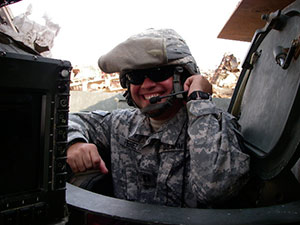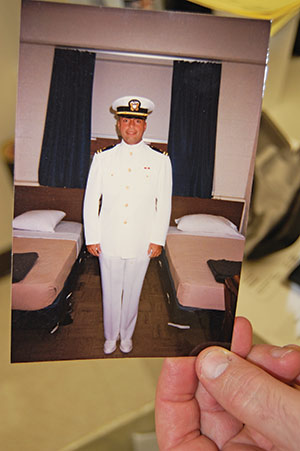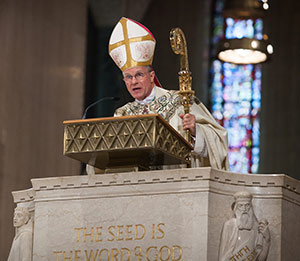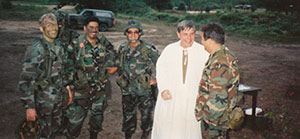“I wouldn’t be around today if it wasn’t for my chaplain assistant,” said Fr. John Perez, chaplain at the Clement J. Zablocki VA Medical Center.
He was deployed to Iraq from 2008 to 2009 with the U.S. Army and remembers how close he was to death.  Fr. John Perez, chaplain at the Zablocki VA Medical Center in Milwaukee since 2012, is pictured in an undated photo. (Submitted photos courtesy Fr. John Perez)
Fr. John Perez, chaplain at the Zablocki VA Medical Center in Milwaukee since 2012, is pictured in an undated photo. (Submitted photos courtesy Fr. John Perez)
“He grabbed me and threw me in a bunker,” Fr. Perez said.
He was being flown by Blackhawk helicopter to a hot zone in Iraq under mortar fire with his chaplain assistant, PFC Specialist Gergorio Gonzalez, whose job was to protect him.
When Fr. Perez stepped off the helicopter, he said he remembers seeing mortar flying. But, he said, because of his “New York mentality,” he wanted to take a picture.
“If there’s a big thing happening, you take a picture,” he said.
But he never took that picture due to the quick thinking of Gonzalez. He said if he had taken that photo, he probably would’ve been killed.
“That was the last day with my camera,” Fr. Perez said. “A parish priest isn’t exposed to that. It was a real awakening for me. I’m not at home any more.”
More than six years removed from his deployment, he still remembers Gonzalez as a soldier who “always makes jokes out of things” Fr. Perez said with a laugh.
“He was having problems with the unit … the commander had him under his thumb and that was one of the reasons why I got him. They thought by giving him to me, they were getting rid of their problem,” Fr. Perez said. “But what it did, we bonded and I helped him be a better soldier. So when he came back to the unit, they took him away from me because now he’s a productive soldier. Those bums. I would’ve loved to stay with him.”
Basic training in two branches
Fr. Perez has been a chaplain since 1990, starting with basic training in the Marines and finishing training with the Navy. He is now in the Army.
 Fr. John Perez, chaplain at the Clement J. Zablocki VA Medical Center, is pictured in his uniform on his graduation day in 1991. He is one of about 220 active duty priests serving in the three branches (U.S. Army, Navy/Marines, Air Force) of the chaplain corps.“I think I’m the only soldier in existence, that I know of, who went to two basic trainings in his life … well, three, Marines then Navy and then the Army,” he said.
Fr. John Perez, chaplain at the Clement J. Zablocki VA Medical Center, is pictured in his uniform on his graduation day in 1991. He is one of about 220 active duty priests serving in the three branches (U.S. Army, Navy/Marines, Air Force) of the chaplain corps.“I think I’m the only soldier in existence, that I know of, who went to two basic trainings in his life … well, three, Marines then Navy and then the Army,” he said.
Chaplains often talk about the bond that’s developed between military personnel and themselves as something special, but as the wars in Iraq and Afghanistan wind down, the number of Catholic chaplains continues to decrease.
“The military diocese depends on other dioceses, the bishops, to give them priests so that they can train them to be chaplains in the military,” Fr. Perez said. “As the population of Catholic priests dwindles in the dioceses, the bishops are less willing to give up any priests.”
According to the Archdiocese for the Military Services, USA, there are roughly 300,000 Catholic military personnel — approximately 25 percent of the total armed forces. Those individuals and their families are served by Catholic chaplains.
There are more than 220 active duty priests serving in the three branches (U.S. Army, Navy/Marines, Air Force) of the chaplains corps. There are more than 380 additional contract priests from other dioceses tasked with serving on different bases and VA centers throughout the country on a case-by-case basis.
What many don’t know is the Archdiocese for the Military Services also provides Catholic services to U.S. State Department individuals abroad, e.g., ambassadors and people who work in a U.S. embassy, bringing to roughly 1.8 million, the number of Catholics served by the Archdiocese for the Military Services, with a little more than 600 available priests.
For every one chaplain there are about 3,000 Catholics as compared to the Archdiocese of Milwaukee where about 680 diocesan and religious order priests serve 591,890 Catholics, according to the 2015 Wisconsin Pastoral Handbook, or about one priest to every 870 Catholics.
Military faces shortage of chaplains
“That’s a tremendous shortfall from what it has been in the past, which of course means the priests are stretched very thin,” Archbishop Timothy P. Broglio of the Archdiocese for the Military Services, told the Catholic Herald in a telephone interview. “It also means that many installations either don’t have a priest or they have to depend on a priest from the outside.”
To be a chaplain in the military, a priest needs to have an endorsement from the church to show he is in good  Archbishop Timothy P. Brogliostanding with the church, be no older than 42 years old, complete basic training and other courses for whichever branch he is entering. Often Catholic chaplains will serve in a parish for several years before entering the military.
Archbishop Timothy P. Brogliostanding with the church, be no older than 42 years old, complete basic training and other courses for whichever branch he is entering. Often Catholic chaplains will serve in a parish for several years before entering the military.
Seven priests of the Archdiocese of Milwaukee are retired from military chaplaincies. Of those, two are involved in ministry unrelated to the military. Currently, no archdiocesan priest is serving in the Archdiocese for the Miltiary Services.
Archbishop Broglio, who has been archbishop of the miltary services since 2007, said each branch has recruiters that, like military recruiters, go into the community and “beat the bushes” to find those who are interested in becoming chaplains. However, budget cuts to the Department of Defense and Veteran Affairs often hinder the ability to hire priests.
“With reducing everything, sometimes that also affects their ability to fund religious education or fund things that we would consider essential, but the military might tend to consider not as essential,” Archbishop Broglio said. “We have to do all of our own fundraising.”
Four times a year, Archbishop Broglio said, the archdiocese can have a “designated offering” during Mass so people can donate.
“That means people are told that the offering this Sunday will go to the archdiocese,” he said. “And if they’re generous, then it’s a good collection for us.”
Religious rights of soldiers protected
Individuals in opposition to having a chaplain corps have suggested the military do away with the program altogether. Refuting that idea, Archbishop Brolgio said soldiers’ religious rights are protected under the First Amendment.
“They have not signed off that they are renouncing their religious freedom just because they’re serving the country on a ship,” he said. “A religious program is the responsibility of the commander of the base or of the ship or of the air field. It is his responsibility to ensure that the men and women, and their families, have the same religious opportunity that they would in civilian life.”
Congressmen urge waiver to allow more chaplains
The Archdiocese for the Military Services has some allies in Congress, including U.S. Rep. Jim Sensenbrenner (R-Wis.) who signed a bipartisan letter dated Feb. 27, addressed to the Secretary of the Air Force Deborah Lee James, urging her to open up the branch to more Catholic chaplains.
“… We write to express our concern over the extreme shortage of Catholic chaplains available to serve the Catholic Airmen of the United States Air Force,” reads the letter signed by 12 members of Congress, including Sensenbrenner and fellow Catholic, U.S. Rep. Sean Duffy (R-Wis.).
“We are aware that, although roughly 25 percent of airmen are Catholic, Catholic chaplains compose only about 11 percent of the Air Force Chaplaincy. We are also aware that the Air Force is unwilling to grant waivers to recruit Catholic priests over the age of 42 and to retain those already serving past their 62nd birthday,” they wrote, adding, “This is a cause for great concern.”
Without Catholic chaplains to meet the needs of the military personnel, they wrote that the airmen were being denied necessary spiritual care.
“This could be interpreted as an infringement of their First Amendment guaranteed exercise of their faith,” they added.
Catholics have unique spiritual needs
In a telephone interview with the Catholic Herald, Sensenbrenner called the Catholic faith unique in that only Catholic priests can administer sacraments.
“In order to go to Mass, in order to go to confession, there has to be a priest there,” he said.
Sensenbrenner said simply having chaplains from other religious denominations isn’t enough.
“There needs to be more Catholic chaplains,” he said. “Basically so that the sacraments will be available to Catholic members of the military. Now I know that’s not always possible, but certainly having the same number of chaplains that they have now inhibits Catholics the ability to profess their faith.”
Sensenbrenner explained that he attended a dinner in Washington, D.C. with Archbishop Broglio who told him about the issue.
“He was very, very frustrated that a lot of his flock simply did not have the access to the sacraments that they should have because there are not enough Catholic chaplains,” Sensenbrenner said. “When you’re on a ship, for example, in the Navy and you’re deployed for months at a time, that’s a heck of a long time not to be able to attend Mass or go to confession.”
Sensenbrenner added that the issue couldn’t be solved with policy.
“It doesn’t need legislation,” he said. “Congress doesn’t deal with individual personnel problems and that’s why the members who signed the letter did so.”
As the Catholic Herald went to press, there has been no response to the letter from James’ office.
Looking ahead to vocation of service
Some are answering the call themselves. One of those is transitional Deacon Daniel Swartz, 26, from the Diocese of Columbus, Ohio, undergoing priestly formation at Pontifical College Josephinum.
“I’ve had a fascination with the military; in fact, I was thinking about becoming an officer in the Marine Corps for a while,” Deacon Swartz said. “Once I entered the seminary, the thought of being involved in the military never really subsided in its entirely.”
Deacon Swartz said the primary reason for him wanting to become a chaplain is because of the need for them.
“When you hear about guys down range or out at sea and they go a number of days or months without the sacraments, that just really tugged at my heart,” Deacon Swartz said. “Even if I don’t turn this into a career, I can give them a certain amount of time.”
Deacon Swartz said he’s looking forward to entering the military.
“I have to go through basic (training) just like everybody else, so I have to be doing that one of these summers,” Deacon Swartz said. “It’s funny to think about. A priest at boot camp; it happens.”
He’s already been commissioned by the military. Following his ordination, scheduled for May 2016, he will enter boot camp. But he said he’ll be with a parish for a while before officially being an active duty chaplain.
“Between myself and the bishop of Columbus, we decided it would probably be wise to take a couple years of ministry within the diocese,” Deacon Swartz said. “I’ll be in the diocese for three years and then the possibility of me going to active duty will occur.”
Swartz plans on becoming an active duty chaplain in 2019.
Archbishop Listecki a retired chaplain
Archbishop Jerome E. Listecki knows challenges and rewards of being a military chaplain, having served in the U.S. Army reserves from 1981 to 2004, and retiring as a lieutenant colonel.
“The uniqueness of the chaplain in the military is the fact that they’re claimed as having a relationship to the enlisted, at the same time they carry rank, so they’re an officer,” Archbishop Listecki said. “Many times an enlisted (soldier) would come to a chaplain before they would come to anyone else in the officer corps. At the same time, because the chaplain carries rank, he sits at the table with other officers carrying that rank as an officer and therefore because of his rank he has to be respected.”
 Archbishop Jerome E. Listecki chats with troops in this undated photo. He spent 23 years as a chaplain in the United States Army Reserves. Looking back on that time, he says it was a privilege to assist the troops in the practice of faith. (Submitted photo) Although he was activated for Desert Storm in the 90s, Archbishop Listecki was never deployed.
Archbishop Jerome E. Listecki chats with troops in this undated photo. He spent 23 years as a chaplain in the United States Army Reserves. Looking back on that time, he says it was a privilege to assist the troops in the practice of faith. (Submitted photo) Although he was activated for Desert Storm in the 90s, Archbishop Listecki was never deployed.
“What would happen to me, being a Catholic chaplain, is I would get pulled in, activated with a unit to basically serve the unit, but then return to my reserve rank,” he said, adding that as a member of the unit he would be alongside his soldiers the entire time. “If you’re in a helicopter unit, as I was, you fly with them. If you’re in an infantry unit, you march with them.”
Archbishop Listecki served as an installation chaplain for part of his time and said he would celebrate upward of nine Masses on a weekend.
“When you’re a chaplain, you’re blessed to be given this kind of ministry,” he said. “You’re inspired by the dedication by the young people you work with.”
He would also do his part to help those who didn’t identify themselves as Catholic.
“Not only would I (celebrate) a Mass but I’d do a non-denominational liturgical service. I was amazed that whenever I would bring in donuts I always had more people,” he said.
One service in particular stands out in his mind.
“This one young lieutenant, he bowed his head and said a prayer in thanksgiving (prior to eating his) donut,” Archbishop Listecki said, adding this took place while everyone else dove into their food. “He didn’t do it for show; he did it because it was coming from him, and it told me about the integrity of the man.”
It’s been 11 years since he’s left the military but Archbishop Listecki said he never forgets his time in the service.
“A month does not go by where I don’t receive a phone call, email or a letter from somebody that I was involved in the military with,” he said. “There’s a bond that’s created. A bond that’s created that lasts your entire life.”
